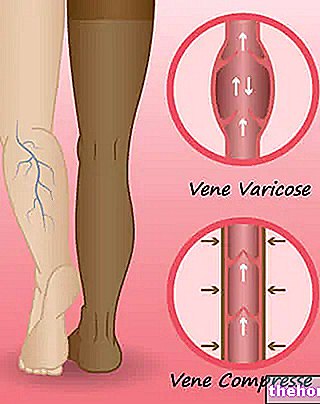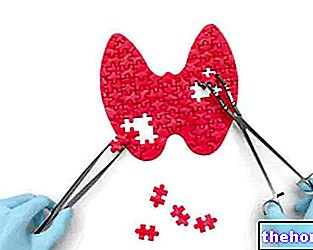Generality
A stenosis is an abnormal and unnatural narrowing of a blood vessel, a hollow organ, an orifice and, in general, of any tubular anatomical element; the presence of this narrowing obstructs the normal passage of what passes inside it (for example, blood, urine, food, etc.).

Example of stenosis: narrowing of a blood vessel due to atherosclerosis
Among the possible causes of stenosis, there are factors such as: atherosclerosis, congenital anatomical alterations, infections, inflammatory processes, diabetes, tumors, cigarette smoke, etc.
From the point of view of pathogenesis, doctors and experts in human anatomy classify strictures in: functional and organic strictures. Generally, the former are temporary, while the latter are permanent.
There are at least 6 different types of strictures: the strictures of the digestive system, the strictures of the respiratory system, the strictures of the cardiovascular system, the strictures of the urinary system, the strictures of the female genital system and the strictures of the nervous system.
What is stenosis?
Stenosis is the term used by doctors to indicate an abnormal and unnatural narrowing of a blood vessel, a hollow organ, an orifice and, in general, of any anatomical structure with a tubular shape.
In order to be able to speak of stricture proper, this narrowing must be such as to make it difficult - but not impossible - to pass the contents (blood, urine, food, body fluids of various kinds, etc.).
Although almost always referred to the aorta (ie the main artery of the human body), a synonym for stenosis, which deserves a particular mention, is coarctation.
ORIGIN OF THE WORD
The term "stenosis" comes from the Greek word "sténosis" (στένωσις), which means "shrinkage".
RE-FORMATION OF A STENOSIS
Sometimes, even when treatments are adequate and timely, a stenosis can re-form in the same previous position and cause the same disorders that caused the previous narrowing.
The re-formation of a stenosis is called restenosis.
Causes
Possible causes of a stricture include:
- Atherosclerosis. This condition is responsible for lesions within the arteries. As a result of such injuries, the inner lumen of the affected arteries can narrow. A narrowing of the arterial lumen impairs blood flow along the affected artery.
- Congenital defects, i.e. anatomical alterations of organs or other structures present from birth.
- Diabetes
- Iatrogenic factors. The "iatrogenic adjective" refers to "something that is induced by the doctor or medicine", obviously without any intention.
To understand better, those conditions or complications that arise directly or indirectly due to the therapist's interventions (understood as a person or as a therapeutic remedy) can be defined as iatrogenic. An example is urethral stricture following a prostatectomy (surgical removal of the prostate) or TURP (partial removal of the prostate). - Infections
- Inflammatory or irritative processes
- Processes of ischemia
- Tumors (or neoplasms). A solid tumor is a mass of cells which, due to the space occupied, can compress adjacent organs and anatomical structures. If the organs or adjacent anatomical structures are tubular hollow elements, the compression induced by the tumor can restrict the size of the internal lumen of the aforementioned elements and cause stenosis phenomena.
This particular compression process, caused by solid neoplasms, is called the "tumor mass effect". - Cigarette smoke
- Calcification processes
- Trauma of various kinds. Traumatic events capable of causing stenosis are, for example, burns, cold or shocks.
- Drugs or toxic substances
PATHOGENESIS: FUNCTIONAL STENOSIS AND ORGANIC STENOSIS
From the point of view of pathogenesis (ie how a certain morbid process is established), doctors classify strictures in: functional and organic strictures.
Functional strictures include all those narrowings resulting from spasms (or contractures) of the sphincters or of the muscular walls making up the hollow organs.
Generally, functional strictures are temporary, so after a certain amount of time there is a spontaneous restoration of normalcy.
Possible causes of functional stenosis: limited burns, the phenomena of perfrigeration, local inflammatory processes, infections, the intake of certain drugs or contact with certain toxic substances.
Moving on to organic stenosis, all narrowings due to persistent anatomical alterations fall into this category.
Organic strictures can be congenital or acquired (that is, developed over the course of life).
Potential causes of an acquired organic stenosis are: particularly severe inflammations, severe burns that cause the formation of scar tissue, trauma of a certain entity, parasitic lesions (therefore infections) or neoplastic processes.
Organic strictures: intrinsic and extrinsic strictures
For organic strictures, doctors thought of a "further subdivision: intrinsic organic strictures and extrinsic organic strictures.
Intrinsic organic strictures are all the narrowings that derive from an "anatomical alteration of the internal wall of the affected hollow organ".
On the other hand, extrinsic organic stenoses are all the constrictions that result from processes located outside the walls of the hollow organ concerned.
General features
According to medical books, a stricture is distinguished by at least 4 basic general characteristics:
- The entity or severity, ie the degree of reduction in the caliber of the anatomical element concerned.
- The extension, ie the length of the stretch affected by the narrowing.
- The duration of the shrinkage. There are, in fact, occasional, intermittent, temporary stenosis and persistent, permanent stenosis.
- Progressivity, that is the tendency to continuous worsening. Some strictures can result in a "total occlusion of the affected hollow anatomical element."
Diagnosis
For a correct and definitive diagnosis of stenosis, diagnostic imaging tests are essential, such as CT (or Computed Axial Tomography), nuclear magnetic resonance (MRI), X-rays, ultrasound procedures (NB: these vary depending on the organ involved) or coronary angiography.
Types
Pathologists distinguish strictures based on where the narrowing resides.
According to this criterion of distinction, there are at least 6 types of stenosis and numerous subtypes.
The 6 types of strictures are:
- The strictures of the digestive system, the main subtypes of which are:
- Esophageal stricture
- Cardial stenosis
- Pyloric stenosis
- The stenosis of the small intestine (precisely the subapillary duodenal)
- Biliary stenosis
- The stenosis of the large intestine
- The stenosis of the respiratory system, the main subtypes of which are:
- Laryngeal stenosis
- Tracheal stenosis
- Bronchial stenosis
- The stenosis of the cardiovascular system, the main subtypes of which are:
- The valve stenosis
- Stenosis of large, medium and small caliber arteries
- Venous stenosis
- Strictures of the urinary system, the main subtypes of which are:
- Stenosis of the renal calyxes
- Strictures of the ureters
- Urethral stricture (ie of the urethra)
- The stenosis of the female genital system, the main subtypes of which are:
- Tubal stenosis
- Stenosis of the cervical canal
- Vaginal stenosis
- Strictures of the nervous system, the main subtypes of which are:
- Vertebral stenosis (or spinal stenosis)
- Strictures that affect the CSF circulatory system (i.e. CSF or cerebrospinal fluid)
STENOSIS OF THE DIGESTIVE SYSTEM
Esophageal stricture and cardial stenosis affect, respectively, the esophagus and the cardia (ie the valve that separates the esophagus from the stomach); their presence causes food regurgitation.
Pyloric stenosis affects the pylorus, which is the region of passage between the stomach and duodenum. Its appearance is a reason for vomiting and gastrectasia.
Subapillary duodenal stenosis affects the duodenum and usually causes vomiting containing bile.
Biliary stricture affects the biliary tract and is responsible for hepatic colic and signs of cholestasis.
Finally, the stenosis of the large intestine induces the appearance of defecation disorders, with stunted or slowed bowel movements, and occlusive or subocclusive syndromes.
STENOSIS OF THE RESPIRATORY SYSTEM
Laryngeal stenosis is the abnormal narrowing of the larynx; tracheal stenosis is the abnormal narrowing of the trachea; finally, bronchial stenosis is the abnormal narrowing of the bronchi.
The most characteristic symptom of stenosis of the respiratory system is dyspnea (or shortness of breath): in general, dyspnoic disorders are more serious the more the obstacle is located high up along the airways.
Other possible clinical manifestations are: cough, noisy breathing and stagnation of catarrhal secretions at the bronchial level.
Stenosis of the Cardiocirculatory System
A valve stenosis is the pathological narrowing of one of the 4 heart valves, which are: the mitral valve, the aortic valve, the bicuspid valve and the pulmonary valve.
If not treated properly, a valve stenosis can lead to heart failure.
Arterial stenosis (or arterial stenosis) is abnormal narrowing of the vessels that carry oxygenated blood to various organs and tissues in the body. Typical consequences of arterial stenosis are: upstream of the narrowing, hypertension and dilation of the vessel caliber, and, downstream of the narrowing, hypotension and reduced blood flow.
Finally, venous stenosis is the abnormal narrowing of the vessels that lead oxygen-poor blood back to the heart.
The typical clinical manifestations of venous stenosis include: stasis edema, phlebectasis (phenomena of dilation of the veins) and varices before narrowing.
STENOSIS OF THE URINARY SYSTEM
Stenosis of the renal calyxes and strictures of the ureters can cause partial or total hydronephrosis, infections and / or abdominal pain.
Urethral stricture - ie stenosis of the urethra - can cause: alterations in the flow of urine (for example: a reduction of the mito or spray mito), infections, painful urination, incomplete emptying of the bladder, blood in the urine, need to urinate often and / or incontinence.
STENOSIS OF THE FEMALE GENITAL SYSTEM
Tubal, cervical and vaginal stenosis can lead to hydrosalpinx (obstruction of the fimbriae and tubal distention with non-purulent fluid), hematometra (collection of blood in the uterine cavity) and hematocolpo (collection of blood in the vagina), respectively.
STENOSIS OF THE NERVOUS SYSTEM
Vertebral stenosis is the pathological narrowing of one or more areas of the vertebral (or spinal) canal, the canal in which the spinal cord resides, a fundamental component of the central nervous system (together with the brain).
Generally, those who develop spinal stenosis complain of: pain (due to the crushing of the spinal cord, caused by the narrowing of the spinal canal), paraesthesia, weakness and reduced reflexes.
As for the strictures that affect the liquor circulatory system, these are mainly responsible for hydrocephalus and symptoms associated with this condition.
Among the stenoses that affect the liquor circulatory system, the stenosis of the Silvio aqueduct and the so-called atresia of the foramina deserve a particular mention.




























